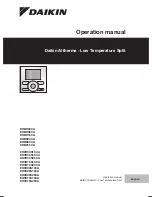
TEMPERATURE ADJUSTMENT
This regulator can be set to control at any temperature
within the limits of the temperature range stamped on
the name plate. After placing the regulator in service,
allow about 15 –30 minutes to reach stable operation,
then watch temperature, if not correct change
temperature setting as outlined hereafter. Make new
settings as necessary until desired temperature is
obtained. Allow about 15 –30 minutes between
changes. Oversized valves will cause extreme
temperature fluctuations.
SETTING TEMPERATURE
Turn the hand wheel in the direction indicated by arrow
(see Figure No. 9). This will compress regulating spring
and cause valve to control at a higher temperature; turn-
ing hand wheel in opposite direction causes valve to
control at a lower temperature. The wheel is mounted
on ball bearings to eliminate friction and insure easy
operation.
CHECKING VALVE STEM TRAVEL
ON TWO-WAY VALVES
The 1/2" to 2" (15 to 50 mm) bronze body regulators
have a 1/4" (6 mm) valve movement.
The 2-1/2" (65 mm) up to and including the 4" (100 mm)
flanged body valves have a 7/16" (11 mm) valve stem travel.
To check stem travel, proceed as follows:
1. See Figure No. 9.
2. Raise temperature at bulb until valve shuts off.
3. Mark lower stem using Stuffing Box Nut as
reference point.
4. Cool entire unit until bellows contracts
completely into housing.
5. Reference mark should be either 1/4" or 7/16" (6
or 11 mm) above stuffing box nut, as indicated.
If valve stem has more travel than indicated, valve will
not shut off.
CHANGING VALVE DISC MOVEMENT
Under some conditions, it may be necessary to adjust the
amount of valve movement. This may occur on oil heater
installations, where only a very small quantity of steam is
required. Too much valve opening is usually indicated by
a decided fluctuation of the oil temperature.
The adjustment is made by holding the upper valve stem
and loosening the stem adjustment lock nut and then turn-
ing the lower valve stem to the left (clockwise) as looking
at the arrow marks on the bracket. This will decrease the
amount of valve movement. See Figure No 8.
Always securely tighten the stem adjustment lock nut
after adjustment has been made.
MAINTENANCE
VALVE STEM PACKING:
Apply one drop of oil to the packing every three months.
Replace the packing once a year, or every 6 months
in severe environments.
1. Remove packing nut.
2. Lift the packing gland.
3. Install new packing.
4. Replace and hand tighten packing nut.
STRAINERS:
Clean once a month, or more frequently if dirt or
debris is present.
Y-Strainers:
1. Open the blowdown valve.
2. Allow the steam or water to flow out for 2 minutes.
3. Close the valve.
Built-in Strainers on Body code 01 or 02 (single-seated type)
1. Remove the bottom plug.
2. Remove and wash screen
3. Reinstall screen and plug.
TRAPS:
Follow trap manufacturer's maintenance instructions.
REGULATOR BODY
STUFFING BOX NUT
LOWER VALVE STEM
UPPER VALVE STEM
TEMPERATURE
ADJUSTMENT WHEEL
STEM ADJUSTMENT
LOCK NUT
PACKING NUT
PACKING GLAND
PACKING
5
Figure No. 9
Figure No. 10
Summary of Contents for Bell & Gossett Hoffman Specialty 1140 Series
Page 11: ...11...






























